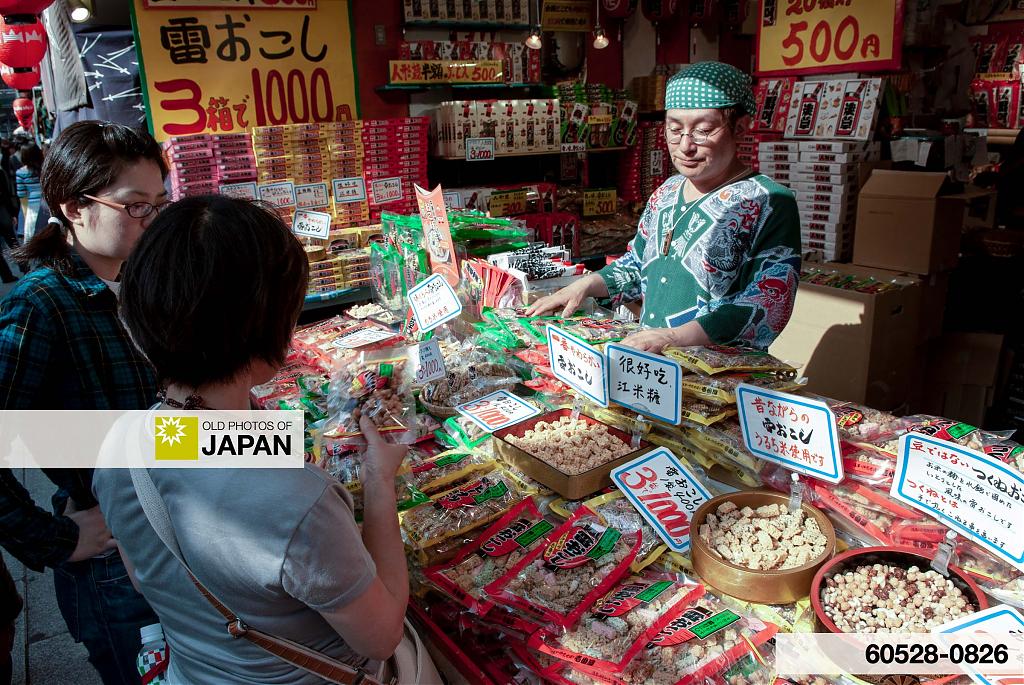This photo of a crowd walking past shops along the approach to the Buddhist temple Senso-ji was taken some time in May 1934. Notable is that while most men and even the children already wear Western clothing, the women still wear kimono.
The shops, called Asakusa Nakamise (浅草仲見世) were a great crowd pleaser as can be seen on this photo. The shops’ origins are rooted in a harvest festival called Tori no Ichi (酉の市).1 Held in November, long lines of people would wind their way along the rice paddies to pray and enjoy themselves at Senso-ji. Naturally this attracted a large number of enterprising merchants to cater to them.

The merchants and entertainers were mostly located on Sensoji Okuyama (浅草寺奥山), the entertainment district behind the temple. Between 1688 and 1735, neighborhood merchants were allowed to open their shops in the approach to the temple as well. The shops were so successful that they developed special products called Asakusa Meibutsu (浅草名物). These included Asakusa Nori (sheets of edible seaweed), Asakusashi (浅草紙, a kind of paper), Tondari Hanetari (small mechanical toys that jump), and Fusayoji (房楊枝), fairly large tufted toothpicks made from willow trees or shrubs and used to clean the teeth as an early version of the toothbrush.
Many shops employed beautiful women to attract customers. Some of these kanban musume (literally “billboard girls”) became quite celebrated in Edo (current Tokyo). Famous woodblock artists like Suzuki Harunobu (鈴木春信, c. 1725–1770) and Kitagawa Utamaro (喜多川歌麿, ca. 1753–1806) even created ukiyoe of them.
Especially famous was O-Fuji (お藤), a kanban musume of the fusayoji shop Yanagiya (柳屋). She was one of three famous bijin (beautiful women) of the Meiwa Era (明和, 1764–1772).2

In 1885 (Meiji 18), brick shops were built, the first modern nakamise at Asakusa. Merchants to enter the nakamise were selected by lottery, and all other shops were removed from the temple grounds.
Shortly after, in March of 1889 (Meiji 22), American scholar Alice Mabel Bacon (アリス・メイベル・ベーコン, 1858–1918), who for many years lived in Japan and was the first Western woman to live in a Japanese household, visited these shops and delightfully described them in her book A Japanese Interior3:
When we had come as near to the temple as the kurumas were allowed to approach, we got out to walk the rest of the way; but we had to pass a line of small shops, in which every conceivable variety of toy is kept, and so attractive was the display that we succumbed to the temptation, spent all our time at the toy-shops, and did not reach the temple at all. I have made up my mind that if I undertake a collection of any kind while I am out here, it will be of toys. I think that in a complete collection of the toy tools, implements, furnishings, etc., one could bring home the largest possible amount of the every-day life of Japan, and with the least possible expenditure of money. I have begun with a ceremonial tea service, a box of carpenter’s tools, and a small kitchen. This last is the most perfect little thing that you can imagine, — a Japanese kitchen, with all its fittings and utensils, even to the knives and skimmers, the dust-pan, the matches, and the god-shelf. It is now before my eyes as I write, and you might suppose you were looking into a kitchen through the wrong end of an opera-glass, for there are no shams about it; everything is made as carefully as if for use.
The shops were destroyed during the Great Kanto Earthquake of 1923 (Taisho 12), but they were rebuilt in concrete in 1925 (Taisho 14). The interior of these shops were in their turn destroyed during the aerial bombing of Tokyo in 1945 (Showa 20). But the concrete structures survived and the shops were rebuilt after the end of the war.
The shops are still there and still attract huge crowds, although now more foreign tourists than Japanese.

For more information about the entertainment around Sensoji Temple, read Tokyo 1920s • Hanayashiki, Asakusa Park and my articles about Yoshiwara, the red light district in the neighborhood of Asakusa.
This glass slide is one of a series of slides of Japan that was used by the New York State Education Department to teach students about Japan.
Notes
1 浅草・酉の市(とりのいち)。Tori no Ichi. Retrieved on 2008-10-23.
2 江戸東京博物館。浅草今昔展。Retrieved on 2008-10-23.
3 Bacon, Alice Mabel (1894). A Japanese Interior. Houghton, Miflin and Company, 159-160.
4 For more information about the Nakamise, visit Asakusa Nakamise Web-site.
Published
Updated
Reader Supported
Old Photos of Japan aims to be your personal museum for Japan's visual heritage and to bring the experiences of everyday life in old Japan to you.
To enhance our understanding of Japanese culture and society I track down, acquire, archive, and research images of everyday life, and give them context.
I share what I have found for free on this site, without ads or selling your data.
Your support helps me to continue doing so, and ensures that this exceptional visual heritage will not be lost and forgotten.
Thank you,
Kjeld Duits
Reference for Citations
Duits, Kjeld (). Tokyo 1934: Asakusa Nakamise, OLD PHOTOS of JAPAN. Retrieved on December 12, 2025 (GMT) from https://www.oldphotosjapan.com/photos/440/asakusa-nakamise




There are currently no comments on this article.